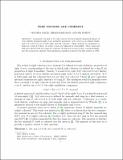Files in this item
Free monoids are coherent
Item metadata
| dc.contributor.author | Gould, V | |
| dc.contributor.author | Hartmann, M | |
| dc.contributor.author | Ruskuc, Nik | |
| dc.date.accessioned | 2016-12-16T00:32:39Z | |
| dc.date.available | 2016-12-16T00:32:39Z | |
| dc.date.issued | 2017-02 | |
| dc.identifier | 224611483 | |
| dc.identifier | 51a88dee-9cad-453b-829c-e35122261ca7 | |
| dc.identifier | 84976567965 | |
| dc.identifier | 000392129500008 | |
| dc.identifier.citation | Gould , V , Hartmann , M & Ruskuc , N 2017 , ' Free monoids are coherent ' , Proceedings of the Edinburgh Mathematical Society , vol. 60 , no. 1 , pp. 127-131 . https://doi.org/10.1017/S0013091516000079 | en |
| dc.identifier.issn | 0013-0915 | |
| dc.identifier.other | ORCID: /0000-0003-2415-9334/work/73702038 | |
| dc.identifier.uri | https://hdl.handle.net/10023/9979 | |
| dc.description.abstract | A monoid S is said to be right coherent if every finitely generated subact of every finitely presented right S-act is finitely presented. Left coherency is defined dually and S is coherent if it is both right and left coherent. These notions are analogous to those for a ring R (where, of course, S-acts are replaced by R-modules). Choo, Lam and Luft have shown that free rings are coherent. In this note we prove that, correspondingly, any free monoid is coherent, thus answering a question posed by the first author in 1992. | |
| dc.format.extent | 5 | |
| dc.format.extent | 245987 | |
| dc.language.iso | eng | |
| dc.relation.ispartof | Proceedings of the Edinburgh Mathematical Society | en |
| dc.subject | Free monoids | en |
| dc.subject | S-acts | en |
| dc.subject | Coherency | en |
| dc.subject | QA Mathematics | en |
| dc.subject | T-NDAS | en |
| dc.subject.lcc | QA | en |
| dc.title | Free monoids are coherent | en |
| dc.type | Journal article | en |
| dc.contributor.sponsor | EPSRC | en |
| dc.contributor.institution | University of St Andrews. School of Mathematics and Statistics | en |
| dc.identifier.doi | 10.1017/S0013091516000079 | |
| dc.description.status | Peer reviewed | en |
| dc.date.embargoedUntil | 2016-12-15 | |
| dc.identifier.grantnumber | EP/I032282/1 | en |
This item appears in the following Collection(s)
Items in the St Andrews Research Repository are protected by copyright, with all rights reserved, unless otherwise indicated.

